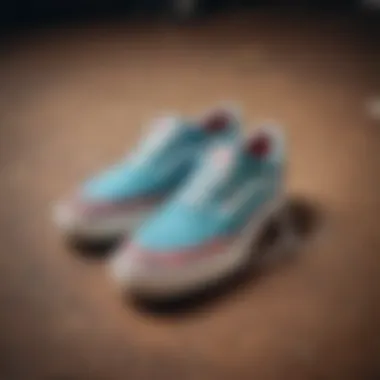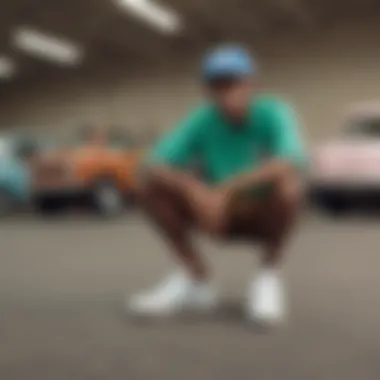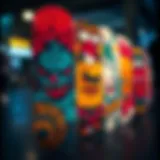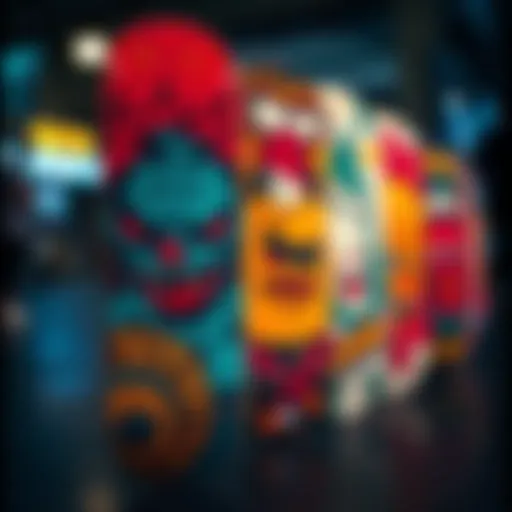Vans Golf Wang: The Fusion of Skate and Style


Intro
The fusion of skate culture and fashion is not just a trend; it’s a vibrant dialogue that shapes both industries and influences countless enthusiasts worldwide. The collaboration between Vans and Golf Wang, the streetwear brand helmed by the creative mastermind Tyler, the Creator, represents a significant chapter in this ongoing conversation. This pairing brings together a legacy of skateboarding roots and bold, expressive fashion. As we peel back the layers of this collaboration, we will explore how it is revitalizing perceptions of skate culture and reshaping contemporary fashion.
Skateboarding has long been associated with a particular aesthetic, a mixture of comfort and edge. Vans, a staple in the skate community, has thrived on this ethos since its inception, carving a niche that resonates deeply with skaters. Golf Wang, with its unique and colorful designs, broadens this narrative, pushing boundaries and creating a dialogue about what skatewear can embody. The intersection of these two cultural forces not only promotes creativity but also stimulates conversations about identity and self-expression within the skate community.
This article delves into various facets of this collaboration, assessing its impact on contemporary fashion trends, the thoughts of those deep-rooted in skate culture, and the broader implications for the future of lifestyle brands. Through careful analysis of design philosophies, public reception, and future trends, we will navigate this terrain, providing clarity on how Vans and Golf Wang are more than just two names—they are a redefining force in an ever-evolving culture.
In the sections that follow, we’ll explore skills development within skateboarding, examine gear and equipment that supports this dynamic lifestyle, and see how the art of skating intersects with fashion. Strap in for an insightful ride through the world of skate culture and its fashionable expressions.
Historical Context of Skate Culture
To fully appreciate the venture between Vans and Golf Wang, it's pivotal to grasp the historical momentum behind skate culture. Skateboarding isn't just a sport; it's a lifestyle, a distinct form of expression that intertwines art, community, and attitude. The roots of this culture trace back to the 1950s and 1960s, as surfers in California began to adapt their surfboards to land, giving birth to what we now know as skateboarding.
Origins of Skateboarding
The early days of skateboarding were characterized by a rugged spirit, where individuals crafted homemade skateboards using whatever they could find. This was a rebellious time for youth, a form of escapism and creativity. Picture kids racing down suburban hills, their homemade boards clattering against rough pavements, embodying a sense of freedom. Fast forward to the 1970s, and you see skateboarding evolve into a sport with a culture of its own. The introduction of urethane wheels revolutionized the ride, making it smoother and faster, leading to the first skate parks appearing across the U.S.
The Rise of Skate Brands
With the growing popularity of skateboarding, brands began to emerge, each seeking to capture the essence of this youthful rebellion. Companies like Powell Peralta, Santa Cruz, and Vans staked their claims, promoting not just products but a way of life. Vans, in particular, became synonymous with skateboard culture. As skaters adorned their feet with the classic slip-ons, it wasn't merely a fashion statement; it signified affiliation and identity within a tight-knit community of thrill-seekers.
Influence of Skate Culture on Fashion
As skateboarding grew, so too did its influence on the fashion industry. Skate culture was marked by a unique aesthetic, blending comfort and edge, which began to seep into mainstream fashion. Loose-fitting jeans, graphic t-shirts, and, of course, skate shoes became staples in wardrobes far beyond the skate parks. Skateboarding’s ethos of self-expression resonated with countless individuals, igniting trends in streetwear that defined entire generations.
Skate culture provides a canvas for personal expression, where the individual’s style speaks louder than words.
Its impact transcends boundaries, influencing high fashion runways and everyday outfits alike. The collaboration between Vans and Golf Wang epitomizes this broad network of expressions; it marries the functionality needed for skateboarding with the artistic ambitions of modern street fashion. Understanding this foundation provides necessary context when exploring how that partnership thrives at the crossroads of culture and creativity.
Intro to Vans
The story of Vans is steeped in the rich cultural tapestry of skateboarding, making it an invaluable pillar of this article. Understanding the brand's origins, its evolution, and its unique identity provides crucial context when examining the collaboration with Golf Wang. The significance of Vans isn't limited to its shoes; it extends into a lifestyle, embracing not just skaters but broader youth culture.
Founding and Evolution
Vans was founded in 1966 by Paul Van Doren, along with his brothers James and Gordon, and partner Serge D’Elia, in Anaheim, California. They set out to create something different in the footwear market. Initially named the Van Doren Rubber Company, they manufactured shoes directly for consumers. This moves, rather innovative for its time, gave customers the ability to choose custom designs and colors. The first day of operation saw them selling 12 pairs of shoes, an underwhelming start, but it quickly grew as word spread.
Over the years, Vans adapted to the culture surrounding them. By the late 1970s, they became synonymous with skateboarding. In fact, as skaters began wearing Vans for their grip and durability, they recognized Vans as a skate brand. The infamous waffle sole design provided a dependable grip on the board, which established Vans as a household name among skateboarders, surfers, and casual wearers alike. This evolution reflects how the brand, much like skate culture itself, is resilient and unafraid of change.
Vans in Skateboarding
Vans' relationship with skateboarding is a prime example of symbiosis — a mutual benefit where both parties thrive. The brand's first significant endorsement came from legendary skater Tony Alva, who helped catapult Vans into the skating limelight. This partnership not only promoted Vans shoes but allowed for the creation of signature styles that catered specifically to the needs of skaters.
In the 1980s, the brand's visibility skyrocketed with events like the first-ever Vans Warped Tour, merging music and skateboarding into a vibrant cultural phenomenon. This era established Vans not just as a footwear provider but as a cultural leader in the skate community. By fostering relationships with various skaters and sponsoring competitions, Vans became a celebrated icon, helping to define the very essence of skateboarding apparel.
Brand Identity and Aesthetic
Vans wears its heritage on its sleeve (or rather, its heel). The brand’s designs exude a laid-back, rebel attitude reflective of skater values. When you think of Vans, images of checkered patterns, bold colors, and classic silhouettes come to mind. These elements have created a timeless aesthetic that resonates well beyond skate parks.
Through collaborations, such as the one with Golf Wang, Vans has showcased its ability to blend with streetwear culture, while remaining steadfast in its skate roots. The juxtaposition of Vans' classic look and Golf Wang’s vibrant, artistic vision represents a harmonious blend that appeals to both skaters and fashion enthusiasts alike.


The brand remains synonymous with rebellion and creativity, creating shoes that not only serve a functional purpose but also represent an individual's personal style. This identity enriches the conversation around the Vans and Golf Wang collaboration, as it positions the shoes not merely as products but as cultural artifacts that encapsulate the spirit of a generation.
Overview of Golf Wang
Understanding Golf Wang is crucial to comprehending the collaboration with Vans. The brand encapsulates a vibrant confluence of creativity, street aesthetics, and the unmistakable flair of Tyler, the Creator. Established in 2011, Golf Wang rapidly became a notable player in the streetwear scene, capturing the attention of youth culture and skaters alike. Its unique approach to fashion not only influences clothing but also resonates deeply within the skateboard community, making it a vital point of discussion in this analysis.
Founding by Tyler, the Creator
Tyler, the Creator, an influential figure in music and art, founded Golf Wang in Los Angeles. With a distinctive vision, Tyler sought to create a brand that reflected his personal style and ethos. Unlike many brands that arise from corporate motives, Golf Wang stems from an authentic connection to art and expression. Tyler’s influence is palpable in every design, which often features bright colors, whimsical graphics, and a sense of playfulness rooted in youth culture. The brand began as a small venture, initially selling t-shirts online through Tyler’s music platform. However, it quickly blossomed into a widely recognized name in streetwear, captivating a generation seeking individualistic and bold attire.
Core Values and Design Philosophy
The core values of Golf Wang center around inclusivity, individuality, and the celebration of creativity. These principles are not mere marketing tools but rather expressions of Tyler's belief in self-acceptance and artistic freedom. The brand's design philosophy leans towards the unconventional, prioritizing vibrant patterns and a mix of vintage and modern influences. Each collection tells a story, blending the whimsical nature of childhood nostalgia with contemporary streetwear trends.
Some key elements of Golf Wang’s design philosophy include:
- Unique Color Palettes: Bold and clashing colors are a hallmark of the brand, capturing attention while also conveying a deeper sense of fun.
- Playful Typography: Custom fonts and graphics help differentiate Golf Wang from competitors, making their clothing instantly recognizable.
- Street Aesthetic with Personal Touches: Tyler often draws inspiration from his life experiences, embedding personal stories and reflections into the designs.
Golf Wang’s Impact on Streetwear
Golf Wang has made significant strides in redefining what streetwear means today. The brand's focus on creativity and self-expression has resonated particularly well with the younger generation, who often seek authenticity over mere branding. Pairing products like oversized sweatshirts and colorful socks with skateboards has solidified its presence in skate culture.
Moreover, Golf Wang has influenced other brands to adopt a more playful and expressive approach to streetwear. The fusion of athletics and high fashion has altered not just aesthetics but the conversations around identity and representation in fashion.
"Golf Wang encapsulates a spirit of fun and individuality that appeals to a broad spectrum of young people, bridging gaps between music, art, and fashion."
In summary, Golf Wang represents more than just a clothing line; it embodies a movement of artistic expression that resonates deeply with its audiences. Its intersection with skate culture highlights a significant evolution in how streetwear is perceived and consumed, making it essential to the ongoing dialogue between fashion and lifestyle.
The Collaboration: Vans and Golf Wang
The partnership between Vans and Golf Wang stands as a compelling chapter in the narrative of skate culture and fashion. This collaboration demonstrates how two distinct yet overlapping realms can create a unique synergy, pushing boundaries and reshaping standards within both industries. It extends beyond the mere exchange of logos and products, delving into a deeper ideological alignment that resonates with various audiences.
Conceptualization of the Partnership
Understanding how this partnership took shape is essential to comprehend its impact. The concept emerged during a time when skateboarding had moved significantly into mainstream consciousness yet retained its underground roots. Tyler, the Creator, known for his bold personality and unconventional ideas, sought to fuse his unique aesthetic with a brand that has long held a cherished position in the skate community.
The collaboration initially seemed like a fascinating experiment, blending Tyler's surreal, playful vision with Vans' longstanding commitment to skate culture. It wasn't merely an attempt at commercial success; it represented a thoughtful exploration of shared values—creativity, authenticity, and community connectivity. All these made for a project that was not just visual, but deeply rooted in the cultural fabric of both entities.
Design Elements and Considerations
The design elements that came out of this collaboration are nothing short of remarkable. Each piece captures Tyler's distinctive artistic vision while remaining true to the quintessential Vans style. Bright colors and playful patterns frequently characterize Golf Wang's aesthetic, and these elements resonate within the designs produced in this partnership. The incorporation of both brands’ motifs creates a stunning visual experience that draws the eye and challenges conventional skatewear norms.
Some crucial considerations that influenced the design include:
- Cultural Relevance: Ensuring the designs speak to the lifestyle of skaters while appealing to fashion enthusiasts.
- Functionality: Staying aligned with skateboarding’s physical demands, emphasizing comfort and durability.
- Innovation: As seen in the introduction of bold colorways and unusual fabric combinations, pushing the envelope of what skate shoes can look and feel like.
The eclectic mix of styles reflects a transition in skate culture itself, with an increasing acceptance of bold and artistic expressions.
Product Range Overview
The product range arising from the Vans and Golf Wang collaboration showcases a broad spectrum designed to cater to various tastes while maintaining a cohesive brand identity. The collection includes items such as sneakers, apparel, and accessories, all of which are defined by a playful yet authentic spirit. For instance, the iconic Vans Slip-On often features vibrant prints and unexpected graphics, which invite conversation and highlight individuality.
Some standout elements in their product offerings include:


- Vans x Golf Wang Sneakers: Offering unique silhouettes with intricate detailing.
- Apparel: Ranging from graphic tees to statement jackets, each tells a story.
- Accessories: Complementing the footwear and clothing, including socks and hats, designed with a mix of function and flair.
Overall, the range is a testament to how inventive design can foster a connection among various demographics, bridging gaps between skateboarders, fashion aficionados, and the cultural zeitgeist.
“This collaboration is about more than clothing; it’s about redefining norms and inspiring a generation.”
Cultural Impact of the Collaboration
The melding of Vans and Golf Wang isn't just a partnership; it's a cultural movement that resonates through various layers of skate and street life. At its core, this collaboration creates an intersection where artistic expression meets consumer fashion, leading to a flavorful mix that appeals not only to skate enthusiasts but also to a broader audience that yearns for individuality and creativity.
Reception within Skateboarding Communities
When the Vans Golf Wang collection surfaced, it wasn’t just met with open arms. Many in the skateboarding community had mixed feelings. On one side, die-hard fans heralded it as a fresh breath into an often monotonous sea of skate gear. The funky colors and unique designs broke away from the typical subdued aesthetic most brands promote. Skateboarders felt a sense of pride as they embraced clothing that differed from the mainstream approach, an approach that often sidelines expression in favor of mere functionality.
However, others felt a twinge of skepticism. Some purists critiqued the collaboration as a commercialization of skate culture, suggesting that Golf Wang’s detour into skate fashion camouflaged the gritty authenticity the scene stands for. To them, turning skate gear into high-fashion statements felt like an avenue where the essence of skateboarding could be diluted, potentially creating a divide between those who skate for sport and those who wear gear for style. Yet, as with all art, evolution is part of the game. The emotional dialogues surrounding this collection often reflect deeper cultural rifts.
Influence on Youth Culture
Golf Wang's influence extends beyond just clothing; it shapes youth culture in potent ways. Tyler, the Creator embodies the ethos of creativity and openness. His partnership with Vans resonates with a generation that is redefining boundaries. Young folks no longer segregate styles but blend skate, hip-hop, and high fashion seamlessly. This collection offers a tangible message: it’s acceptable to be multifaceted in your style selections.
Moreover, the presence of Golf Wang has positioned skateboarding in a spotlight that embraces diversity. The presence of bright colors and eclectic patterns in the collection provides youth with options that reflect their vibrant lifestyles and personalities. When kids gravitate towards these bright options instead of the more subdued tones, they are making a choice to embrace their individuality. The combination of skateboarding and fashion aligns perfectly with their quest for authenticity amidst a curated social media world.
Fashion Trends Emerging from the Collaboration
This collaboration undoubtedly birthed new fashion trends that spill over into various domains. Firstly, the blending of traditional skate footwear with bold prints and artistic motifs illustrates a shifting paradigm where functionality does not compromise flair. Skate shoes have evolved from being utilitarian to becoming style icons, showcasing wild graphics and colors that celebrate personal expression.
As a result, we’ve seen an uptick in vibrant patterns and quirky cuts across various lines, with skate culture becoming a significant influence in contemporary fashion. It’s not uncommon to see everyday citizens donning pieces that echo the playful spirit of the Golf Wang collection without even stepping on a skateboard. This speaks volumes about the broader implications of skate fashion transcending its initial confines, entwining effortlessly into mainstream consciousness.
In summary, the Vans Golf Wang collaboration serves as a critical case study, showcasing how the interface of skate culture and fashion can flourish, attesting to the dynamic, ever-evolving nature of youth culture and self-expression.
Vans Golf Wang: A Study in Brand Synergy
The collaboration between Vans and Golf Wang stands as a fascinating example of brand synergy in today's fashion landscape. At its core, this partnership exemplifies how two distinct brands can converge to harness their unique strengths and appeal to a shared audience. The importance of understanding this synergy lies in recognizing how it reshapes not only the skatewear market but also the broader cultural narratives surrounding both skateboarding and fashion.
Aligning Visions and Audiences
The alignment of visions between Vans and Golf Wang is not merely a coincidence; it’s a calculated partnership reflecting the essence of what each brand stands for. Vans, with its deep-rooted connection to skate culture, maintains an ethos centered around self-expression and community. On the flip side, Golf Wang, spearheaded by Tyler, the Creator, taps into creativity and individuality, pushing boundaries on visual presentation.
This united front speaks volumes to audiences that crave authenticity and relevance. For younger consumers, the overlap feels personal; it validates their identities as skaters and fashionistas. The colors, patterns, and motifs seen in the product range represent more than aesthetics; they embody a lifestyle.
Both brands have positioned themselves to appeal to a demographic that cherishes the quirks of street style but also respects the heritage of skate culture. This collaboration allows both brands to expand their horizons and reach audiences that might not have engaged with them otherwise. The impact is amplified by social media reach where skate videos often intermingle with fashion showcases.
Mutual Benefits Realized
In exploring the mutual benefits accrued from the Vans and Golf Wang partnership, it becomes evident how their collaboration addresses several objectives that may have been difficult to achieve independently.
- Brand Exposure: Vans capitalizes on Tyler's strong influence, especially among Gen Z and Millennials, thus introducing the brand to a broader audience that may typically engage more with streetwear than with traditional skate brands.
- Innovation in Design: Golf Wang's vibrant and whimsical design philosophy pushes Vans into new realms. The collections often feature bold, unexpected color palettes and playful graphics that stand out in the otherwise monochromatic world of skatewear.
- Cultural Relevance: Together, they resonate not just with skaters but also with consumers searching for ways to express their individuality while maintaining a strong connection to the skate community. This approach widens the market influence for both brands, merging enthusiasts with casual consumers.
- Collaborative Events and Releases: The partnership leads to unique events, limited edition drops, and engaging marketing strategies that excite both brand's audiences, generating buzz and anticipation.
Challenges Faced by the Collaboration
In an age where brand collaborations can often fall victim to commercialism, the union of Vans and Golf Wang did not come without its fair share of hurdles. This collaboration isn't merely a marketing exercise; it’s a delicate dance between skate culture and high fashion. The stakes are high because genuine skate culture has roots in authenticity and community, while fashion often thrives on trends and profit. Understanding the challenges faced by this partnership provides insight into the broader implications of merging these worlds.
Navigating Brand Expectations


One of the foremost challenges both entities confronted was aligning their brand expectations. For Vans, known for its heritage in skateboarding, the expectation is to maintain credibility within the skating community. The brand has built its image on authenticity; any perceived capitulation to manistream fashion could alienate loyal skaters. The collaboration with Golf Wang, a brand that often embraces flamboyant aesthetics and bold colors, presents a risk to Vans' carefully curated image.
Golf Wang carries its own unique ethos, one that reflects Tyler, the Creator's artistic vision. Balancing these distinct reputations required constant communication and a solid understanding of each brand's core message. Both companies had to navigate what aspects of their identities could meld together without compromising their authenticity, ensuring that the partnership did not dilute the essence of either brand.
The challenge here isn’t just in blending visual styles but also in maintaining the spirit that each brand embodies, especially in a skateboarding context. They needed to ask tough questions: Is this collaboration a reflection of our true identities? Will it resonate with our target audiences? Achieving a synergy that satisfies both sides while not alienating their traditional fan bases was paramount for successful execution.
Addressing Criticism from Purists
Despite the creative aspirations behind the Vans and Golf Wang collaboration, it quickly faced skepticism, particularly from purists entrenched in skate culture. Skateboarding, with its roots in rebellion and grassroots movements, often sees any shift towards commercial viability with a critical eye. This requires acknowledging that for some members of the skateboarding community, the blend of high-fashion elements may feel out of place or unjustifiable. Understanding and addressing this criticism was vital for the collaboration's longevity.
Skeptics argued that the introduction of a high-fashion brand could undermine the cultural significance of skateboarding as a form of self-expression. Comments on social media platforms, such as those found on Reddit, displayed a mixed bag of sentiments, with some users praising the designs while others categorically dismissed them as not being "true skate".
Addressing these concerns required a transparent approach from both brands. Incorporating authentic skate elements in their marketing materials was crucial. Featuring actual skaters in the campaign instead of fashion models, for instance, helped bridge the gap and intrigue traditionalists. This kind of thoughtful engagement reflects a respect for the culture Vans represents while still innovating within the landscape of street fashion.
Future Implications for Skateboarding and Fashion
In today’s rapidly changing culture, the synergy between skateboarding and fashion carries significant weight. The collaboration between Vans and Golf Wang stands as a case study illustrating how such partnerships can shape future trends and redefine expectations within both industries. By interweaving skate culture with fashion elements, this partnership not only attracts a broader audience but also reinforces the relevance of skateboarding in mainstream fashion.
Evolving Trends in Skate Fashion
The landscape of skate fashion is in a state of constant flux. Emerging designers are infusing traditional skatewear with fresh ideas, materials, and styles. This evolution is particularly visible in the use of vibrant colors and graphic designs that echo the artistic expressions found in street art. For instance, Golf Wang's bold palettes and distinct patterns set a departure from the muted tones typically associated with the past.
Skaters are increasingly opting for clothing that merges functionality with fashion, offering both style and performance. This shift suggests a generation that values not just what they wear while riding but what they express through their attire. Furthermore, brands like Vans are paying closer attention to feedback from skaters, ensuring that comfort and usability remain at the forefront of their designs.
- Key Trends
- Use of unconventional materials that prioritize comfort and durability.
- Integration of tech wear elements for heightened functionality.
- Collaborations with street artists, musicians, and influencers extend the narrative of skate culture into fashion narratives.
As we look ahead, the trend is leaning towards a more inclusive approach that welcomes diverse styles while still holding onto the rebellious spirit of skate culture.
Potential for Future Collaborations
The Vans and Golf Wang collaboration showcases a successful blend of skate culture with avant-garde fashion design. This model has opened the door to countless other partnerships, which could result in innovative product lines that resonate with a wide audience. Future collaborations may take several forms, including those that emphasize sustainability or showcase local artists.
Exploring these partnerships, brands that tread deeply into the roots of skate culture can tap into uncharted territories. For instance, brands commonly associated with high fashion or luxury could develop collections that maintain skate culture's essence while introducing new, upscale design philosophies. This can potentially elevate the status of skatewear in luxury markets, creating a bridge between high fashion and everyday streetwear.
Moreover, collaborations may extend into experiences, where brands host skate events or community workshops, challenging the traditional boundaries of retail. Through these initiatives, companies not only foster loyalty among existing customers but also attract new ones, ensuring that the culture remains vibrant and perpetually evolving.
"Skate culture has always been about creativity, resistance, and community; its fusion with fashion promises to ignite even greater innovation and movement within both spheres."
As we venture into this new era, it's essential for both skaters and designers to stay abreast of changing dynamics. The future holds exciting possibilities for skate fashion, as it continues to redefine itself, pushing boundaries and expressing individual identity.
Finale
In summing up the exploration of the partnership between Vans and Golf Wang, it's clear that the intersection of skate culture and fashion holds significant weight in today’s lifestyle landscape. This collaboration is not just about shoes or apparel; it’s about redefining what both brands represent in a world where boundaries between fashion and functionality are increasingly blurred. The synergy created through this union serves as a template for future collaborations that seek to bring authenticity and a grassroots vibe to mainstream fashion.
Summary of Key Insights
The partnership has produced a line of products that resonate deeply with skate culture while simultaneously appealing to style-savvy consumers. Key insights from this collaboration include:
- Cultural Resonance: The designs echo the spirit of skateboarding, heavily influenced by Tyler, the Creator's unique aesthetic and Vans' longstanding ties to the skate community. This blend invites a diverse audience into the fold, enriching the skate scene as a whole.
- Innovative Designs: Elements like bold colors, whimsical patterns, and tongue-in-cheek motifs are hallmarks of the Golf Wang line. These designs not only stand out but also allow wearers to express individual creativity, marrying fashion with personal identity.
- Community Response: The reception among skaters and fans reflects a nuanced appreciation for the partnership, with many celebrating the fresh energy it brings while some harbor skepticism rooted in traditional skate values. This dynamic adds layers to the discussion around authenticity in skate culture.
Reflections on the Partnership’s Legacy
Looking ahead, the legacy of Vans and Golf Wang could be viewed as a pivotal moment in how skate culture evolves alongside fashion trends. This partnership has laid the groundwork for future synergies by showing that:
- Commercial Viability: The success of the partnership highlights the potential for other brands to tap into niche communities, proving that there is a profitable intersection between authenticity and commercial interests.
- Diversity in Skateboarding: The collaboration also signals a shift towards inclusivity within the skateboarding culture, showcasing a willingness to embrace eclectic perspectives and styles, which can only serve to enrich the community.
- Enduring Influence: As younger generations of skaters navigate their own identities, the collaboration serves as a reminder of how brands can innovate while remaining respectful of the cultures they represent.
Overall, the Vans and Golf Wang collaboration demonstrates how fashion and skate culture can coexist, leading to a more vibrant, diverse, and inclusive future for both industries. This partnership is a testament to the ever-evolving nature of fashion, driven by community values and creative expression.





